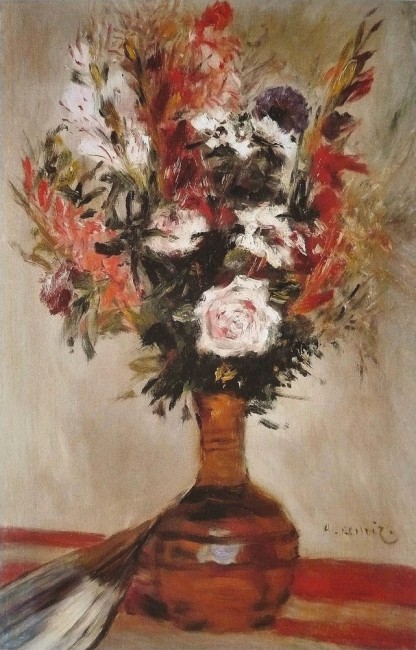
Description of the picture:
Roses – Pierre-Auguste Renoir
Flowers in Renoir’s work occupied no less place than women’s bodies, in which one could clearly admire the forms, the beauty of smooth elastic skin. Especially frequent “guests” on the canvases were roses with their rich texture and variety of colors. Roses in vases, baskets, jugs, woven into a wreath or growing on bushes – all this is unprincipled, the main thing is that the picture was lively, pretty and not boring. So Auguste Renoir considered.
Looking at still lifes with roses, brushes of the majestic French impressionist, it is easy to see how the style of the master changed with age, which is especially evident in the framework of the first plot, if in complex figured compositions.

The first picture of “Roses” was painted in 1866 – it’s cold color, delicate shades that suggest that Renoir is here in the framework of his so-called mother-of-pearl period. The letter is still quite realistic, but with a pronounced individual style.

The second work, “Roses in a Vase”, created in 1872, gives an idea of how the master’s palette began to “warm”. Bright shades and contrasting combinations appeared here, and the composition became closer to the classical than the “Roses” of 1866, written from the top corner. The technique began to acquire familiar properties – vigorous short strokes.

The third still life, “Roses”, dated 1878, is a vivid example of the artist’s transition to the “red period”. Here we see bright pink tones, a contrasting background and a clearly expressed impressionistic texture – small wavy strokes that create a sparkling effect. As if every petal shimmers in the sun.
Tracing the evolution of the painter’s style, one cannot help but notice the general features of his writing – this is the absence of any clear contours, offset by closely spaced strokes, flowing colors into each other and extreme reliability. Renoir always depicted roses at the peak of flowering, when this delightful plant could give maximum pleasure from contemplation. The roses depicted by the artist are always charming and so tangible that it seems that their nose is about to catch their wonderful delicate aroma, despite the specific technique of impressionism, which is far from photographic and realism."